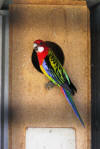. golden mantled rosella

Aviary Notes: Read notes on "Rosellas" web page and use in conjunction with details outlined on this page. Level Of Knowledge Required: Beginner / Intermediate / Advanced / Specialist Breeders Only. Government Regulations & By-Laws: Refer to " Government Laws " web page. Housing Requirements: Refer to " Rosellas " and " Housing Birds " web pages for general details on the housing of Australian Rosellas or read on for specific details for this parrot. Golden mantled Rosellas can be aggressive to other birds and can hybridize with other Rosellas, so is preferable to house these Rosellas as one pair per aviary. An aviary of about 3 metres long, 1 metre wide and 2.1 metres high is ideal. Can be housed and bred in a suspended cage. Leafy branches can be placed in the aviary for the birds to chew up. This will entertain the birds, help minimize boredom and give the birds some beak exercise. Natural branches can be used for perches. These natural perches will be chewed by the birds and may need to be replaced regularly. Diet / Feeding: Refer to " Rosellas " and " Feeding Birds " web pages for general details on the feeding of Australian Rosellas or read on for specific details for this parrot. In the wild, Eastern Rosellas spend a lot of time on the ground foraging for foods. This habit of ground feeding appears to be more pronounced in the Eastern Rosella than the other Rosellas. Because of their preference to feed on the ground in the wild, these birds consume a larger proportion of their foods as seeds or grains from grasses and herbs than the other types of Rosellas. They consume similar foods in the trees and shrubs as the other types of Rosellas. In an aviary situation the food requirements of the Eastern rosella are the same as the other Rosellas. The habit of being a ground feeder may place these birds in a situation that may lead to a higher likelihood of these birds needing treatment for internal parasite infections. Leafy branches can be placed in the aviary for the birds to chew up. This will entertain the birds, help minimize boredom and give the birds some beak exercise. Natural branches can be used for perches. These natural perches will be chewed by the birds and may need to be replaced regularly. Basic diet for the Golden mantled Rosella includes a quality Budgie mix or Canary mix with added sunflower and safflower seed. A variety of fruits and vegetables should make up a good portion of their diet to help avoid excessive weight gain. The Golden mantled Rosella, along with most captive birds, like to nibble on seeding grasses and greens. Leafy green vegetables such as silverbeet and endive should be offered. Fresh eucalypt branches and other suitable fresh branches can be offered so the birds can chew the branches and eat any fruits or berries. The sunflower and safflower seeds can be offered in separate dishes so the breeder can monitor the amount of these seeds consumed. Commercial parrot pellets can form part of a balanced diet. Nesting: A basic overview only. Dimensions are typical / average and can vary widely, influenced by the owner's preferences and the birds preferences. Parent bird's preferences can also be influenced by the size and type of nest-box / log in which the bird was hatched and reared. If space allows, offering a choice of sizes and types of logs or nest-boxes, and placed in various locations within the aviary, can allow the parent birds to make their own choice. Once a pair has chosen a specific nest-box/log and been successful in it, offer that one to them each breeding season. Try and keep that one for their exclusive use. Once a pair has chosen its log or nest-box, the other ones can generally be removed. If the "spare" boxes are to be removed and moved to another flight, ensure the log / nest box is cleaned to ensure the receptacle has the minimal contamination of mites, parasites and pathogens. All Australian parrots will breed in hollow logs.
Timber nest-boxes generally require a climbing structure attached inside the box below the entrance hole. Both logs and nests need an entrance hole/opening of about 65 - 75 mm diameter and about 100 mm (about 4 inches) from the top. Many species of parrots like the entrance hole to be just big enough to squeeze through. More details on parrot nestboxes/logs and a selection of parrot nestbox/log photos can be found on the "nests", "parrot nests" and "parrot nestbox photos" web pages. Click on "Up" then "Nests" then "parrot nests" and "parrot nestbox photos" in the navigation bars. Breeding: Egg Colour White. Clutch/s per year 1, sometimes 2. Eggs per nest 4 - 7. Incubation approx. 20 - 22 days. Fledge approx. 28 - 30 days. Independent approx. another 2 - 3 weeks, sometimes up to 4 weeks. Golden mantled Rosellas are generally good breeders and will accept a log or a nest box. When obtaining stock, try and ensure the birds are pure Golden mantle Rosellas and not hybrids. Artificial incubation and hand rearing or fostering will not be covered on this web site. It is too complex and diverse in nature to be attempted here. Health Issues: Refer to "Avian Health Issues" web page for information and references.
General References: Refer to references listed on "Book References" web page. Specific References:
|